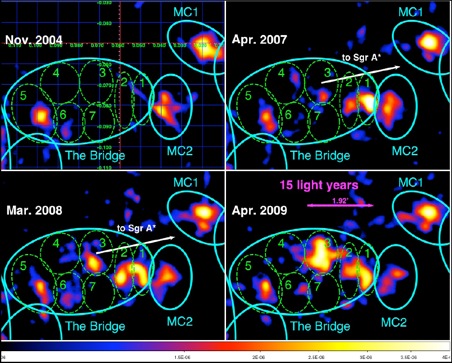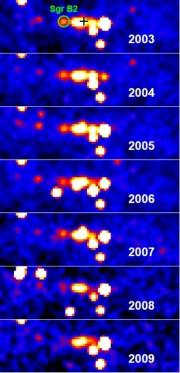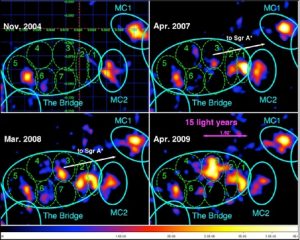Molecular clouds reveal a giant outburst of the supermassive black hole at the centre of the Galaxy
The central black hole of the Galaxy, today surprisingly quiet, has undergone, several hundred years ago, a violent phase of activity. This is the conclusion reached by an international team led by astrophysicists of the APC laboratory and including scientists of the Service d'Astrophysique of CEA-Irfu, by studying the high energy emission of molecular clouds located in the central regions of the Galaxy. The scientists have indeed discovered complex variations of this emission, with some of them showing propagation velocity greater than the speed of light. They reveal that a giant outburst, most probably generated by the black hole, took place about 400 years ago. The powerful flare is visible today after reflection by the molecular clouds that play the role of celestial mirrors. The recent history of the region retraced in this way shows that the black hole of the galactic centre is not so different from the supermassive black holes of the active galactic nuclei. This work, based on two long term observing programs of the XMM-Newton and Integral satellites, is the object of two complementary publications in The Astrophysical Journal.

Light echo of an outburst
At the centre of the Milky Way lurks a black hole of 4 million solar masses identified with the radio source Sgr A*. In spite of a multitude of observation campaign, it appears surprisingly quiet and only the last generation of X-ray telescopes (Chandra et XMM-Newton) has allowed us to detect a weak activity from this object, consisting of sporadic flares. The method used by the researchers to detect traces of the black hole activity has been to study the emission from the numerous molecular clouds [1] located around the galactic center. Indeed, when a molecular cloud is illuminated by high-energy radiation, it reflects the light in the form of a characteristic radiation called fluorescence radiation [2]. This phenomenon, similar to a sound echo, is a well known process observed in many galactic nebulae. The light detected in the 90s from the Sgr B2 molecular cloud, the most massive one of the central region of the galaxy, had been attributed in that way to an outburst of the black hole occurred 300 years ago. However other explanations, like a primary source within the cloud or the interaction of charged particles with the molecular material, could account for those results. The new observations obtained with the Integral satellite over more than six years demonstrate now that the emission from Sgr B2 is without doubts produced by the black hole.
The intensity of the signal observed with the ISGRI camera between 20 and 60 keV decays in a regular way between 2003 and 2009. A complementary observation with XMM-Newton in 2004 excludes the presence, within the cloud, of a variable source bright enough to explain the Integral flux. The strength of the variation, the signal decreases by a factor of two in eight years, does not support an origin due to interaction of particles like protons or electrons. Observations, carried out by another team and that show a similar variation of the fluorescence radiation [2] from Sgr B2, support the model of an origin external to the cloud. The scientists conclude that the Integral emission from Sgr B2 is the reflection of an outburst of the central black hole of the Galaxy. The observed decay corresponds to the outburst decline that started about 100 years ago. This result is supported by the discovery, by the same team, of another cloud, G0.11-0.11, whose fluorescence emission observed with XMM shows an identical decrease: this cloud also witnesses the end of the outburst.
Image : The region of the galactic center as seen by the Isgri camera of the IBIS telescope on board INTEGRAL in the 20 to 60 keV energy range from 2003 to 2009. The intensity of the molecular cloud Sgr B2, indicated by the green circle in the top panel image, shows a clear decline in flux after the 7 years of monitoring, a signature of the black hole outburst decay occurred about 100 years ago. The field of each image is 2 x 6 degrees and typical exposure is roughly of 3 million seconds. Other variable sources in the images are mostly X-ray binaries containing compact objects.

If these two clouds witness the end of the flare, other clouds, located in different positions with respect to the black hole, could betray its birth.
Superluminal variations
During a XMM-Newton survey of the galactic center, scientists have discovered some surprising variations in the X-ray emission of several molecular clouds. The most spectacular of them is displayed by a molecular cloud called the Bridge which switches on gradually at different locations between 2004 and 2009. It is as if an external light front swept the cloud gradually. But the variation takes place in about 5 years while the minimum size of the cloud is 15 light years: the apparent propagation is then three times faster than light! This superluminal echo is an optical illusion and probably results from a projection effect on the sky, due to a geometrical configuration between the source and the molecular cloud. It can be explained by placing the cloud “behind” Sgr A * (relative to the observer) at a distance greater than 50 light years and illuminated by a wave front of high energy radiation nearly parallel to the cloud surface facing the observer and coming from the direction of the black hole.

A not so special black hole
The observation of molecular clouds has thus allowed the scientists to retrace the recent history of the galactic centre black hole. The authors of these two papers conclude that Sgr A* woke up violently about 400 years ago to switch off again about 100 years back, before entering in the present lethargic phase. The intensity of the outburst, one million times the present flux level, make Sgr A* resembling the family of supermassive black hole that reside in the heart of active galaxies. The molecular clouds demonstrate that the central black hole of the Galaxy is probably less atypical than it appeared before.
Contact : Andrea Goldwurm (CEA)
Publications :
« Fading Hard X-ray Emission from the Galactic Centre Molecular Cloud Sgr B2»
Terrier R. (1), Ponti G. (1,2), Bélanger G. (3), Decourchelle A. (4,5), Tatischeff V. (6), Goldwurm A. (1,4), Trap G. (1,4), Morris M. R. (7) and Warwick R. (8), Astrophysical Journal, 2010, for an electronic version arXiv:1005.4807
(1) APC-Paris (F), (2) University of Southampton (UK), (3) ESAC/ESA Villanueva de la Canada (SP), (4) SAp/IRFU-Saclay (F), (5) AIM-Saclay (F), (6) CSNSM/CNRS-Orsay (F), (7) UCLA-Los Angeles (US), (8) University of Leicester (UK)
« Discovery of a Superluminal Fe K Echo at the Galactic Centre: The Glorious Past of Sgr A* Preserved by Molecular Clouds»
Ponti G. (1,2), Terrier R. (1), Goldwurm A. (1,3), Belanger G. (4) and Trap G. (1,3), Astrophysical Journal, 2010 May 1, Vol 714, p. 732, for an electronic version arXiv:1003.2001
(1) APC-Paris (F), (2) University of Southampton (UK), (3) SAp / IRFU-Saclay (F), (4) ESAC/ESA Villanueva de la Canada (SP)
see : the CEA-CNRS Press Release (27 mai 2010)
see also : – “Sursaut au centre de la Galaxie” , Janvier 2003 (in french)
: – “Le trou noir central de la Galaxie” , Octobre 2003 (in french)
Notes :
[1] Molecular clouds are interstellar nebulae consisting mainly of molecular hydrogen (H2) and, in lower proportion, of other molecules like carbon monoxide (CO).
[2] Fluorescence radiation and reflection . Neutral iron atoms illuminated by radiation of energy greater than 7.1 keV can absorb the X-rays by loosing an inner shell electron. This process is often followed by the transition of one electron of the higher shell to the vacant electronic level with the emission of a photon of 6.4 keV, correspondent to the energy level difference. A molecular cloud illuminated by hard X-rays radiates then this specific X-ray line, called fluorescence neutral iron line, and displays a broad absorption feature starting at 7.1 keV (absorption edge). X-rays that are not absorbed can be scattered by the electrons of the external shells loosing little energy. The energy distribution of the scattered X-rays is however slightly modified. These two types of radiation, fluorescence line with absorption edge and scattered continuum, characterise a reflection nebula.
Written by : Andrea Goldwurm, Christian Gouiffès


